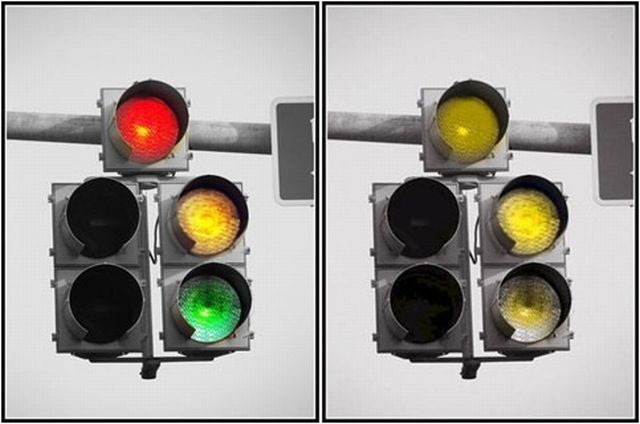
Color Vision Correction
Color Deficiency, sometimes called Color Blindness, makes it difficult to tell the difference between colors. Special Contact Lenses help people who have this problem to be able to perceive color.
What is the difference between Color Deficiency and Color Blindness?
It is common to confuse these two terms because they are similar. Color Blindness means that the individual has no color perception.
Color Deficiency means that the individual has some ability to discriminate between specific colors, but it is difficult to do so.
The difference is that people with Color Deficiency are able to perceive color while those who are Color Blind can not. Color blindness is genetic, which means it runs in families. Special contact lenses can help.

What are the types of Color Deficiency?
Red-Green color deficiency is the most common type. That means that it is difficult to tell the difference between red and green.
Blue-Yellow is the next common color deficiency. It is rare for someone to have Achromatopsia, meaning, not being able to see any color.
Red-Green Color Deficiency
There are 4 types of red-green color blindness:
- Deuteranomaly is the most common type of red-green color deficiency. Green looks more red.
- Protanomaly makes red look more green and less bright.
Both of these are typically mild and usually don’t interfere with normal activities.
- Protanopia and Deuteranopia means that someone is not able to distinguish between red and green at all.
Blue-Yellow Color Deficiency
This color deficiency is less common. Those who have Blue-Yellow Color Deficiency, have more difficulty distinguishing between Blue and Green, and between Yellow and Red.
The 2 types of blue-yellow color deficiency are:
- Tritanomaly: this means that someone has difficulty distinguishing between blue and green, and between yellow and red.
- Tritanopia: this means that someone is not able to tell the difference between blue and green, purple and red, and yellow and pink. It also makes colors look less bright.

What are the symptoms of Color Deficiency?
The main symptom of color deficiency is not seeing colors the way most people do. The individual may have trouble seeing:
- The difference between colors
- How bright colors are
- Different shades of colors
Symptoms of color deficiency may be mild and may be unnoticeable. People may not be aware that they have it.
People with very serious cases of color blindness might have other symptoms, such as nystagmus (quick side-to-side eye movements) or photophobia (sensitivity to light).
Who is at risk for Color Deficiency?
Men have a much higher risk (8%) than women (less than 1%) for color deficiency. It is much more common for someone to have color deficiency:
- If there is a family history of color blindness
- Certain eye diseases such as glaucoma or age-related macular degeneration (AMD) can produce color deficiency.
- With systemic (body) health problems, like Diabetes, Alzheimer’s disease, or Multiple Sclerosis (MS)
- If someone is taking certain medications that cause changes in color perception.
- If someone is Caucasian (white).

When should a child be tested?
Color Deficiency and Color Blindness can be detected and diagnosed in children. Symptoms to look are:
- greater difficulty reading off a chalkboard or doing other activities.
- if a child has trouble learning their colors.
Even small children can be tested. If there is a family history of color deficiency or color blindness, it is particularly important for your child to be tested.
In our office, we routinely test for color vision for both children and adults.
What causes Color Deficiency or color Blindness?
The most common reason for color deficiency or color blindness is Genetics: the trait is passed down from parents. It can also occur due to damage to your eye or your brain because of a disease process. Color vision can become worse with age, due to cataracts (cloudy areas in the lens of the eye).
How can I find out if I have a Color Deficiency or Color Blindness?
In our office, we routinely test for color deficiency in both children and adults.
The Ishihara Test is the most common test. There are other tests as well. In our office we provide further specialized testing such as the Farnsworth D-15. This test is usually required for those who have an occupational need to detect color, such as captains and sailors, electricians, graphic designers, nurses, and airplane pilots.
What’s the treatment for Color Deficiency and Color Blindness?
Special contact lenses compensate for color deficiency and color blindness, just as eyeglasses compensate for someone who is nearsighted or farsighted. Rod-Monochromatism is a genetic disease that causes extreme color deficiency and sensitivity to light.
As stated above, certain eye diseases (Cataract, Glaucoma, Macular Degeneration) and certain systemic (body) diseases, (Diabetes, Brain Injury, Multiple Sclerosis) can cause color deficiency. Some medications that affect the macula can bring on color blindness. If that is the case, then a substitute medication may be used or the dosage (amount of medication) may be adjusted.
If color deficiency or color blindness is causing problems with everyday tasks, or with your occupation, then special contact lenses can be prescribed. At times we prescribe these lenses for only one eye. In more extreme cases they are worn in each eye.
